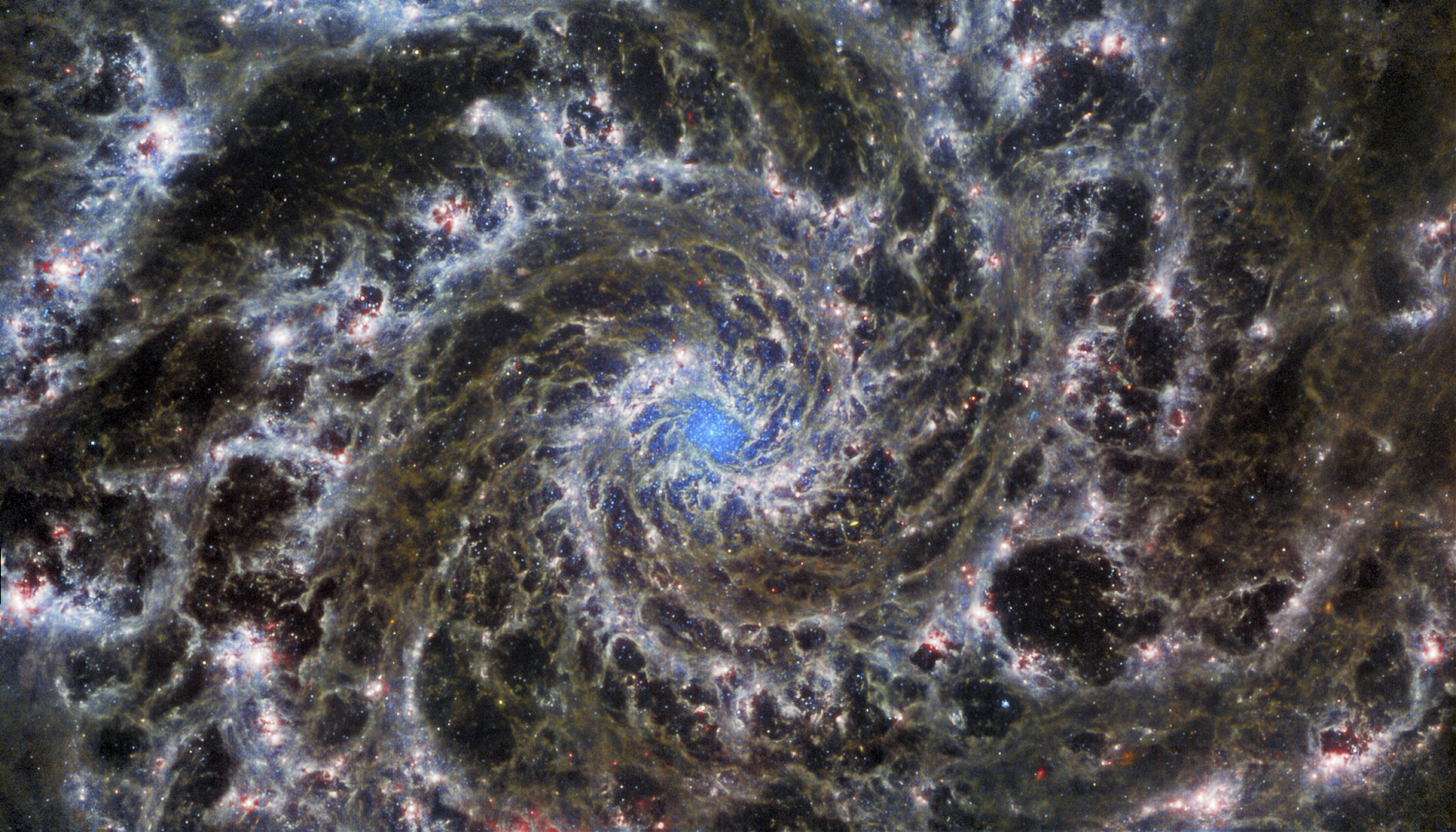New mysteries in the nuclear star cluster of the Phantom galaxy
nuclear star cluster

This image from the NASA/ESA/CSA James Webb Space Telescope shows the heart of M74 (or NGC 628), otherwise known as the Phantom Galaxy. Webb’s sharp vision has revealed delicate filaments of gas and dust in the grandiose spiral arms which wind outwards from the centre of this image. A lack of gas in the nuclear region also provides an unobscured view of the nuclear star cluster at the galaxy’s centre. M74 is a particular class of spiral galaxy known as a ‘grand design spiral’, meaning that its spiral arms are prominent and well-defined, unlike the patchy and ragged structure seen in some spiral galaxies.
The Phantom Galaxy is around 32 million light-years away from Earth in the constellation Pisces, and lies almost face-on to Earth. This, coupled with its well-defined spiral arms, makes it a favourite target for astronomers studying the origin and structure of galactic spirals.
Webb gazed into M74 with its Mid-InfraRed Instrument (MIRI) in order to learn more about the earliest phases of star formation in the local Universe. These observations are part of a larger effort to chart 19 nearby star-forming galaxies in the infrared by the international PHANGS collaboration. Those galaxies have already been observed using the NASA/ESA Hubble Space Telescope and ground-based observatories. The addition of crystal-clear Webb observations at longer wavelengths will allow astronomers to pinpoint star-forming regions in the galaxies, accurately measure the masses and ages of star clusters, and gain insights into the nature of the small grains of dust drifting in interstellar space.
Hubble observations of M74 have revealed particularly bright areas of star formation known as HII regions. Hubble’s sharp vision at ultraviolet and visible wavelengths complements Webb’s unparalleled sensitivity at infrared wavelengths, as do observations from ground-based radio telescopes such as the Atacama Large Millimeter/submillimeter Array, ALMA. By combining data from telescopes operating across the electromagnetic spectrum, scientists can gain greater insight into astronomical objects than by using a single observatory — even one as powerful as Webb!
In this vein, a team of researchers has now combined archival Hubble Space Telescope and new James Webb Space Telescope imaging data covering the ultraviolet to mid-infrared regime to morphologically analyse the nuclear star cluster of the Phantom Galaxy 1.
Nuclear star clusters
Nuclear star clusters are massive and compact stellar systems in galactic nuclei. The effective radii range from a few to tens of parsecs (a parsec is 3.2616 light-years). Such radii are typical of globular clusters and ultracompact dwarfs. Stellar masses may reach up to 109 M⊙ (solar masses), which, in combination with the small effective radii, leads to such core densities that make nuclear star clusters the densest stellar systems known.
The formation and growth of nuclear star clusters depend on the host galaxy mass and, potentially, on the morphological type. They appear frequently, albeit not ubiquitously, at galaxy masses of 109–1010 M⊙ in various environments. A majority of them in high-mass galaxies were discovered in spiral galaxies, likely due to the high central luminosities of massive elliptical galaxies.
The Phantom galaxy is one example of a nucleated, massive galaxy. This grand-design spiral galaxy is located at a distance of 32 million light-years, at the edge of the Local Volume. Both its relatively isolated position and nearly face-on orientation make the Pnantom galaxy an optimal test case for detailed studies of galactic disks and star and cluster formation in massive late types.
Its nuclear star cluster was analysed previously using Hubble Space Telescope (HST) WFPC2 imaging data, but no in-depth analysis of all available high-resolution data had been performed yet. With the advent of the James Webb Space Telescope (JWST) earlier this year, the researchers were able to study the nuclear star cluster of NGC 628 across the optical and infrared regimes, analysing both its structural and photometric properties.
New mysteries
Among the plethora of interesting results, some mysterious phenomena arose. First, the colour, age, and metallicity of the main stellar population of NGC 628’s nuclear star cluster indicate that no star formation has taken place in the previous few gigayears in its centre. This is caused either by a dynamical mechanism preventing gas and dust inflow or by feedback from the centre. The lack of a young stellar population hints that the central cavity, which lacks both gas and dust, has existed for the last few gigayears as well. The reason for the lack of recent in situ star formation and the origin of the central cavity lacks an explanation.
The nature of the emission in the mid-infrared bands remains a mystery as well. It is clear that the old stellar population of the nuclear star cluster cannot completely explain the emission in JWST’s MIRI bands. The authors examine five different mechanisms that may cause the emission. None of them can fully explain both the structural and photometric measurements.
Author: César Tomé López is a science writer and the editor of Mapping Ignorance
Disclaimer: Parts of this article may have been copied verbatim or almost verbatim from the referenced research paper and esawebb.org.
References
- Nils Hoyer, Francesca Pinna, Albrecht W. H. Kamlah, Francisco Nogueras-Lara, Anja Feldmeier-Krause, Nadine Neumayer, Mattia C. Sormani, Médéric Boquien, Eric Emsellem, Anil C. Seth, Ralf S. Klessen, Thomas G. Williams, Eva Schinnerer, Ashley. T. Barnes, Adam K. Leroy, Silvia Bonoli, J. M. Diederik Kruijssen, Justus Neumann, Patricia Sánchez-Blázquez, Daniel A. Dale, Elizabeth J. Watkins, David A. Thilker, Erik Rosolowsky, Frank Bigiel, Kathryn Grasha, Oleg V. Egorov, Daizhong Liu, Karin M. Sandstrom, Kirsten L. Larson, Guillermo A. Blanc, and Hamid Hassani (2023) PHANGS–JWST First Results: A Combined HST and JWST Analysis of the Nuclear Star Cluster in NGC 628 ApJL doi: 10.3847/2041-8213/aca53e ↩